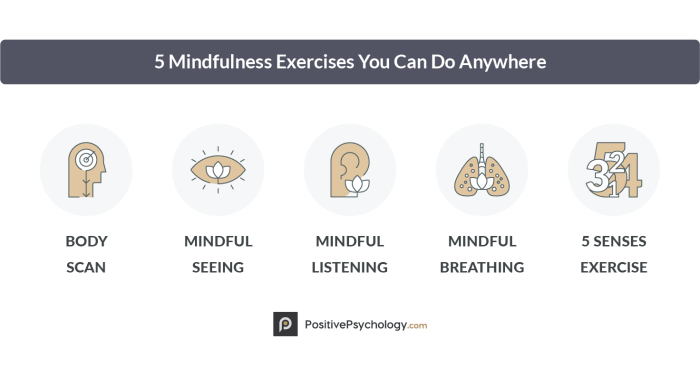Mindfulness Exercises take center stage in the quest for mental well-being, offering a path to inner peace and clarity. Dive into a world where mindfulness reigns supreme, guiding you towards a calmer and more focused existence.
Discover the transformative power of mindfulness exercises as we explore the various types, benefits, and practical tips for incorporating them into your daily routine.
Introduction to Mindfulness Exercises

Mindfulness exercises are practices that help individuals focus on the present moment, increase self-awareness, and reduce stress. These exercises are often rooted in mindfulness meditation techniques and can be beneficial for both mental and physical well-being.
Benefits of Practicing Mindfulness Exercises
- Reduces stress and anxiety levels
- Improves concentration and focus
- Promotes emotional regulation and resilience
- Enhances self-awareness and self-compassion
Examples of Mindfulness Exercises
- Body Scan Meditation: Focus on each part of the body, from head to toe, noticing any sensations without judgment.
- Deep Breathing: Take deep breaths in and out, paying attention to the inhale and exhale rhythm.
- Mindful Walking: Pay attention to each step taken, the movement of the body, and the surroundings.
- Loving-Kindness Meditation: Cultivate feelings of love and compassion towards oneself and others through guided meditation.
Types of Mindfulness Exercises

Mindfulness exercises come in various forms, each serving a unique purpose in helping individuals cultivate awareness and presence in the moment. Let’s explore some of the common types of mindfulness exercises and how they work.
Breathing Exercises
Breathing exercises are a fundamental aspect of mindfulness practice. By focusing on the breath, individuals can anchor themselves in the present moment, allowing them to observe their thoughts and emotions without judgment. One popular breathing exercise is the 4-7-8 technique, where you inhale for 4 seconds, hold for 7 seconds, and exhale for 8 seconds.
Body Scan
Body scan exercises involve systematically bringing attention to different parts of the body, starting from the toes and moving up to the head. This practice helps individuals develop body awareness, release tension, and promote relaxation. By tuning into bodily sensations, individuals can connect with the present moment and cultivate a sense of inner calm.
Meditation
Meditation is a versatile mindfulness practice that can take various forms, such as loving-kindness meditation, mindfulness meditation, or guided visualization. Through meditation, individuals learn to observe their thoughts and emotions without attachment, fostering a sense of clarity and equanimity. This practice helps individuals cultivate a deep sense of presence and self-awareness.
Comparison and Contrast
While breathing exercises focus on the breath as a point of awareness, body scan exercises target physical sensations in the body, and meditation allows for a more open-ended exploration of thoughts and emotions. Each type of mindfulness exercise offers unique benefits and can be tailored to individual preferences and needs.
How to Practice Mindfulness Exercises
To begin practicing mindfulness exercises, follow these simple steps:
Starting Your Practice
- Find a quiet and comfortable space where you won’t be disturbed.
- Sit or lie down in a relaxed position, keeping your back straight and your hands comfortably resting.
- Close your eyes and take a few deep breaths to center yourself and relax.
- Focus on your breath, observing the natural inhalation and exhalation without trying to control it.
Incorporating Mindfulness into Daily Routine
- Start your day with a short mindfulness exercise to set a positive tone for the day.
- Practice mindfulness during routine activities like eating, walking, or showering to stay present in the moment.
- Use mindfulness as a tool to manage stress and anxiety throughout the day.
- Take breaks to practice mindfulness whenever you feel overwhelmed or distracted.
Importance of Consistency
Consistency is key in mindfulness practice as it helps to cultivate a sense of awareness and presence in your daily life.
- Regular practice strengthens your mindfulness ‘muscle’ and makes it easier to stay focused and calm in challenging situations.
- Consistency allows you to deepen your mindfulness practice over time, leading to greater benefits for your mental and emotional well-being.
- Make mindfulness a regular part of your routine to experience its full effects and create lasting positive changes in your life.
Mindfulness Exercises for Different Settings
Practicing mindfulness exercises in various settings can help promote focus, reduce stress, and enhance overall well-being. Here are some mindfulness exercises tailored for different environments:
Mindfulness Exercises for Work Environments
When at work, it’s important to stay present and focused. Try these mindfulness exercises:
- Take a few minutes to practice deep breathing exercises at your desk.
- Engage in a short walking meditation during breaks to clear your mind.
- Practice gratitude by reflecting on positive aspects of your work environment.
Mindfulness Exercises for Outdoors
Connecting with nature can enhance mindfulness. Here are some exercises to try outdoors:
- Go for a mindful walk in a park or natural setting, focusing on each step.
- Practice mindful observation by taking in the sights, sounds, and smells of your surroundings.
- Engage in a grounding exercise by feeling the earth beneath your feet and connecting with the present moment.
Mindfulness Exercises for Stress Relief
During stressful moments, mindfulness exercises can help calm the mind and body. Here are some exercises for stress relief:
- Practice progressive muscle relaxation to release tension in the body.
- Use a body scan meditation to bring awareness to different parts of the body and release stress.
- Practice mindful breathing techniques to center yourself and reduce anxiety.






